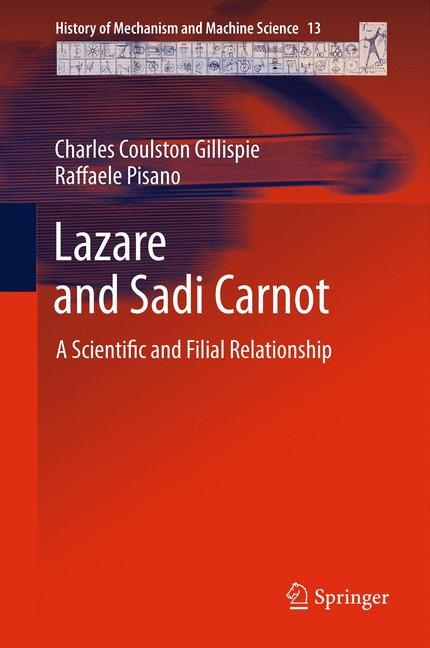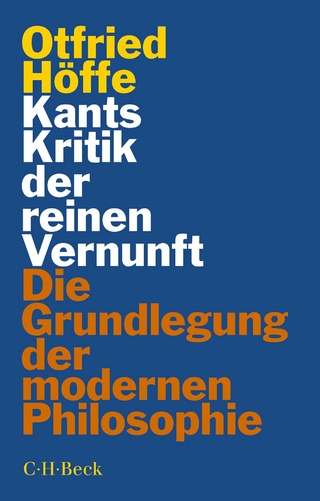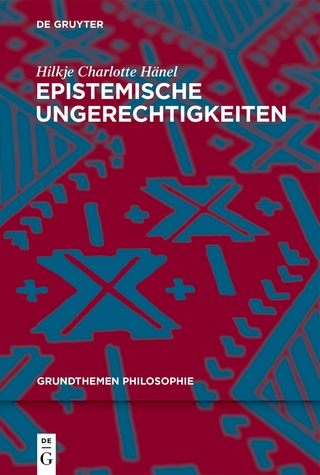
Lazare and Sadi Carnot
Springer (Verlag)
978-94-007-4143-0 (ISBN)
- Titel erscheint in neuer Auflage
- Artikel merken
Lazare Carnot was the unique example in the history of science of someone who inadvertently owed the scientific recognition he eventually achieved to earlier political prominence. He and his son Sadi produced work that derived from their training as engineering and went largely unnoticed by physicists for a generation or more, even though their respective work introduced concepts that proved fundamental when taken up later by other hands. There was, moreover, a filial as well as substantive relation between the work of father and son. Sadi applied to the functioning of heat engines the analysis that his father had developed in his study of the operation of ordinary machines. Specifically, Sadi's idea of a reversible process originated in the use his father made of geometric motions in the analysis of machines in general. This unique book shows how the two Carnots influenced each other in their work in the fields of mechanics and thermodynamics, and how future generations of scientists have further benefited from their work.
PREFACE, by Eberhard Knobloch.- FOREWORD.- ACKNOWLEDGMENTS.- CHAPTER I Biographical Sketch of Lazare Carnot.- CHAPTER II The Science Of Machines: 2.1 Summary of Essai sur les machines en general.- 2.2 Geometric motions.- 2.3 Moment-of -Momentum.- 2.4 Moment-of-Activity-The concept of work.- 2.5 Practical conclusions.- CHAPTER III The Development Of Carnot's Mechanics: 3.1 Argument of the 1778 Memoir on theory of machines.- 3.2 Argument of the 1780 Memoir.- 3.3 Argument of the Principes fondamentaux de l'equilibre et du mouvement (1803).- 3.4 Comparing the work of Sadi Carnot.- CHAPTER IV The Carnot Approach And The Mechanics Of Work And Power, 1803-1829: 4.1 Early engineering mechanics.- 4.2 Applied mechanics.- 4.3 The concept of work.- CHAPTER V An Engineering Justification Of Algebra And The Calculus.- 5.1 Geometric analysis and the problem of negative quantity Quantity.- 5.2 The compensation of error in infinitesimal analysis.- 5.3 Analysis and synthesis.- CHAPTER VI History And Historiography Sadi Carnot's Thermodynamics: 6.1 A historical excursus.- 6.1.1 On the science of Sadi Carnot's time: the mechanics.- 6.1.2 On the science of Sadi Carnot's time: the theory of heat.- 6.1.3 Toward physical mathematical theories.- 6.2 A Historiographycal excursus.- 6.2.1 On Sadi Carnot's historiography.- 6.3 On the methodology used to investigate Sadi Carnot's science.- 6.3.1 On specificity and scientificity in historical discourse.- 6.3.2 On interpretation in historical discourse.- 6.3.3 On categories in history of science.- 6.4 Biographical sketch of Sadi Carnot.- 6.4.1 Notes on the philological aspects of Reflexions sur la puissance motrice du feu.- 6.4.2 On Sadi Carnot's studies at Ecole Polytechnique.- 6.5 An index ad hoc of Reflexions sur la puissance motrice du feu.- CHAPTER VII On Principles In Sadi Carnot's Thermodynamics: 7.1 An outline of the problem of history and logics.- 7.1.1 On the mathematics.- 7.1.2 On the physics.- 7.1.3 On the physics mathematics.- 7.1.4 On logics and structure.- 7.2 Sadi Carnot's theory and its logical organization.- 7.2.1 On DNSs and logical investigation.- 7.2.2 The distribution of DNSs in Sadi Carnot's book.- 7.2.3 The possible theoretical roles played by a DNS.- 7.2.4 Sadi Carnot's arguments through his DNSs.- 7.3 Reconstruction of arguments and some cycles of reasoning expressed by DNSs.- 7.4 Sadi Carnot's thermodynamics as PO theory. Its non-classical logic and its central problem.- 7.5 On Sadi Carnot's theory: a case-study.- 7.6 Which and how many principles did Sadi Carnot express in his Reflexions sur la Puissance Motrice du Feu? .- 7.7 DNSs and mathematics in Sadi Carnot's theory.- 7.8 Final remarks.- CHAPTER VIII What Are The Scientific Roots Of Sadi Carnot's Cycle?: 8.1 An outline of the problem.- 8.2 A comparative analysis: Volta's battery and Sadi Carnot's heat machine.- 8.2.1 An analogy between heat fluid and electric fluid.- 8.2.2 An analogy between the cycle of electric fluid and the cycle on heat states.- 8.2.3 An analogy between heat work and electrical work.- 8.3 On the analogy between thermodynamics and electrostatics according to Mach's investigations.- 8.4 Other kind of analogies.- 8.4.1 On the birth of electricity and thermodynamic theories.- 8.4.2 On the caloric and entropy.- 8.5 Final remarks.- CHAPTER IX Historical Epistemology Of Thermodynamics. The Mathematics In Sadi Carnot's Theory: 9.1 An outline of the problem.- 9.2 A book of physics without mathematics?.- 9.3 The calculations and historical interpretation of the mathematical footnote.- 9.4 The "suppression" of adiabatic curves in Sadi Carnot's cycle.- 9.4.1 Why Sadi Carnot "supprime" the adiabatic curves?.- 9.4.2 A possible solution. Lazare's synthetic method.- 9.4.3 The synthetic method in Reflexions sur la puissance motrice du feu .- 9.5 The mathematical character of the footnote.- 9.6 How did Sadi Carnot use his adiabatic equation? A possible calculation.- 9.7 A reflection on modern calculation of efficiency.- 9.8 Final Remarks.- CHAPTER X Studies And Heritage of Reflexions sur la Puissance Motrice du Feu: 10.1 An outline of the problem.- 10.2 La theorie analytique de la chaleur. Reflections on Fourier and Lame .- 10.2.1 On Fuorier's Theorie analytique de la chaleur (1822) .- 10.2.2 On Lame's Lecons sur la theorie analytique de la chaleur (1861) .- 10.2.3 Final remarks on Fourier and Lame's theories .- 10.3 Theoretical advancements on caloric theory in Sadi Carnot's work .- 10.3.1 On dynamical effects of heat by Ferdnand Reech (1853).- 10.3.2 On cycles and equivalent mechanic of heat.- 10.4 On a comparative analyses between Paul de Saint-Robert's Principes de Thermodynamique (1865) and Sadi Carnot's Reflexions sur la puissance motrice du feu (1824).- 10.4.1 Notes on Paul de Saint-Robert.- 10.4.2 Historical analysis of Principes de Thermodynamique (1865).- CHAPTER XI Final Remarks On The Scientific Relationship between Pere et Fils: 11.1 An outline of the problem.- 11.2 A hypothesis on structure of scientific parentage.- 11.3 On the lost Newtonian paradigm.- 11.4 On the constraints and production of work.- 11.5 On the machines en general and its working substance of machines.- 11.6 On the analogy between hydraulic and heat machines.- 11.7 On the efficiency of a machine.- 11.8 On the impossibility of perpetual motion.- 11.9 On the synthetic method.- 11.10 On the principle of virtual work.- 11.11 On the principle of virtual work and the interactions.- 11.12 On the principle of virtual work and the state equations.- 11.13 Scholars, formulas, experiments and sources cited by Sadi Carnot in his Works.- 11.14 On the equivalence of work-heat.- 11.15 On the cycle and reversibility of a machine.- 11.16 Final remarks a mo of conclusions.- Appendix to Chapter VII.- References.- Index.
| Reihe/Serie | History of Mechanism and Machine Science ; 13 |
|---|---|
| Zusatzinfo | 63 black & white illustrations, 34 colour illustrations |
| Verlagsort | Dordrecht |
| Sprache | englisch |
| Maße | 155 x 235 mm |
| Gewicht | 991 g |
| Themenwelt | Geisteswissenschaften ► Philosophie ► Erkenntnistheorie / Wissenschaftstheorie |
| Mathematik / Informatik ► Mathematik ► Geschichte der Mathematik | |
| Naturwissenschaften ► Physik / Astronomie ► Allgemeines / Lexika | |
| Technik | |
| ISBN-10 | 94-007-4143-X / 940074143X |
| ISBN-13 | 978-94-007-4143-0 / 9789400741430 |
| Zustand | Neuware |
| Informationen gemäß Produktsicherheitsverordnung (GPSR) | |
| Haben Sie eine Frage zum Produkt? |
aus dem Bereich

![Was heißt Denken?. Vorlesung Wintersemester 1951/52. [Was bedeutet das alles?] - Martin Heidegger](/media/113619842)
